Social Welfare
Nasha Mukt Yuva for Viksit Bharat Empowering Minds, Building the Nation
Posted On:
17 JUL 2025 10:47AM
|
Key takeaways
- Over 65% of India’s population is under 35, making youth the key drivers of the vision for a drug-free and developed India.
- In 2024, Indian law enforcement agencies seized drugs worth ₹25,330 crore, an increase of over 55% from the previous year, reflecting intensified action against narcotics.
- The Youth Spiritual Summit in Varanasi (18–20 July 2025) launches a youth-led movement against drug abuse through the “Kashi Declaration.”
|
Introduction
Drug abuse remains a serious global issue. It silently harms individuals, breaks families, and weakens communities. Its effects are not just limited to addiction. It causes long-term physical, mental, and social damage.
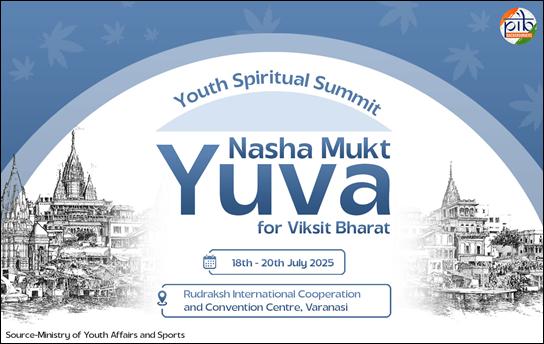
Youth are the torchbearers of Amrit Kaal, the journey towards a Viksit Bharat. With over 65 percent of India’s population under the age of 35 and an average age of just 28 years, our youth are the very driving force of national development. Their strength, energy, and clarity of purpose can transform India’s future if shielded from destructive influences like drug addiction.
Swami Vivekananda once said, “Whatever you think, that you will be. If you think yourselves weak, weak you will be; if you think yourselves strong, strong you will be.” A true inspiration for the youth, Swami Vivekananda guided young minds to stay away from harmful habits like drug use. He believed that anything that weakens a person physically, mentally, or emotionally should be rejected like poison. He encouraged the youth to use their energy and wisdom to build the nation, not destroy themselves.
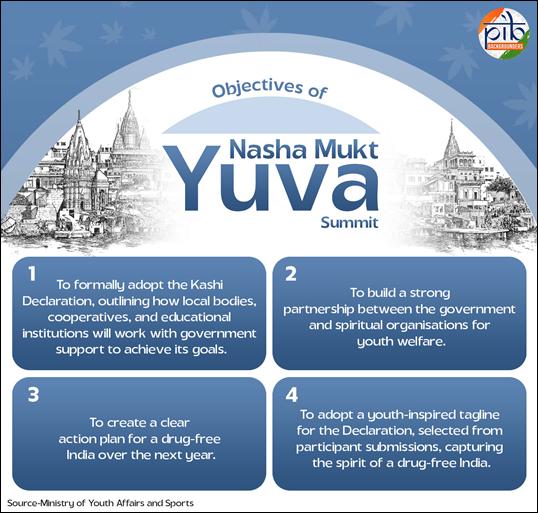
With this vision, the Ministry of Youth Affairs and Sports is organising the Youth Spiritual Summit[1] in Varanasi, from 18th to 20th July 2025. The theme is "Nasha Mukt Yuva for Viksit Bharat". The core aim is to help youth break free from addiction and strengthen their role in nation-building.
This summit will bring together key ministries such as Health, Social Justice, and Culture, along with the Narcotics Control Bureau, AIIMS, and youth wings of over 100 spiritual organisations.
The aim is to create a strong national plan for a youth-led movement against drugs through the “Kashi Declaration,” a joint roadmap for a healthier, drug-free, and developed India. To keep the plan active and transparent, progress will be reviewed during Viksit Bharat Young Leaders Dialogue (VBYLD 2026), ensuring sustained momentum.
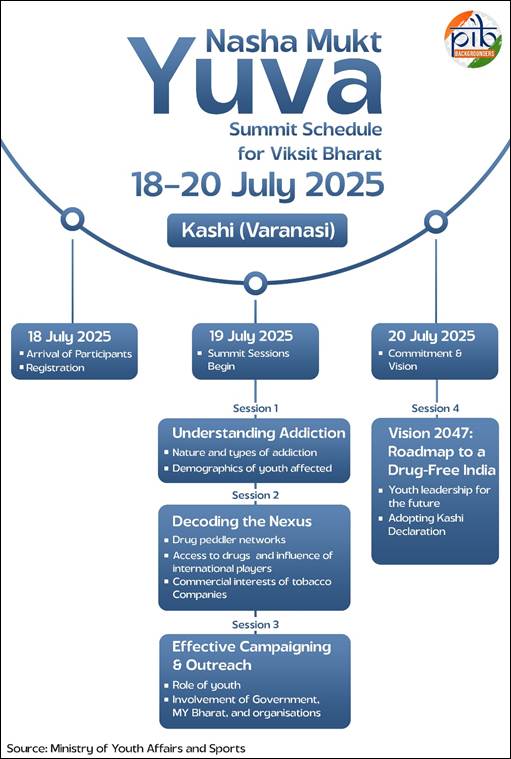
Outcomes of the Summit
- Each session will produce a focused action plan developed by the respective stakeholders.
- These individual plans will be integrated and formally adopted as the Kashi Declaration on Day 2 of the Summit.
- The final resolution will outline specific targets, designate responsible agencies, and establish clear timelines for implementation.
Call for Action: Citizens’ Role in Building a Drug-Free India
The Nasha Mukt Bharat Abhiyaan is not merely a government initiative; it is a nationwide movement that calls for the active participation of every citizen. The involvement of individuals, especially the youth, is critical to transforming this campaign into a people-led Jan Andolan. By taking collective responsibility, citizens can play a key role in prevention, awareness, rehabilitation, and enforcement support.
Ways to Participate
Take the Pledge
Citizens are encouraged to formally express their commitment to a drug-free India by taking the official pledge on the NMBA portal. This pledge symbolises individual accountability in support of a national cause.
Volunteer and Intern
Youth and citizens can enroll as volunteers or interns under the Nasha Mukt Bharat Abhiyaan. Through structured training and field engagement, they can contribute to awareness drives, outreach programmes, and community mobilisation.
Share Credible Information
Members of the public are urged to report any credible information related to drug trafficking or supply to local authorities. Timely intelligence can play a crucial role in dismantling illegal networks and preventing harm.
Utilise Official IEC Materials
The Ministry of Social Justice and Empowerment has developed Information, Education and Communication (IEC) materials, including posters, videos, and creatives that can be used in educational institutions, workplaces, and public spaces. These materials help promote awareness and behaviour change.
Stay Informed with FAQs
A dedicated Frequently Asked Questions (FAQ) section is available on the NMBA website to provide clear and authoritative information on addiction, treatment services, helplines, and the campaign structure.
Download the NMBA Mobile Application
The NMBA mobile application facilitates campaign updates, reporting, real-time data submission by volunteers, and access to support resources.
A Zero-tolerance policy towards drug abuse
The government has adopted a zero-tolerance policy towards drugs with a focused and organised approach. The Government of India has emphasised the need to turn this fight into a Jan Andolan by spreading awareness among the youth and the public to achieve the vision of a drug-free India. In a span of just one year, this approach has led to a significant rise in drug seizures, arrests, and coordinated crackdowns across the country.
In 2024, law enforcement agencies across India, including the NCB seized drugs worth around ₹25,330 crore; over 55% more than the ₹16,100 crore seized in 2023. In 2024, the seizure of more harmful and addictive synthetic drugs, cocaine and pharmaceutical drugs used as psychotropic substances has increased significantly.
ATS (Amphetamine-Type Stimulants) are synthetic drugs that harm the brain, heart and nervous system.
- Methamphetamine (Meth): A crystal-like drug that severely damages the brain and heart.
- Cocaine: A white powder that can cause heart attacks and strong addiction.
- Mephedrone: A party drug that leads to anxiety, confusion and heart issues.
- Hashish: Made from cannabis, it affects memory and mental health.
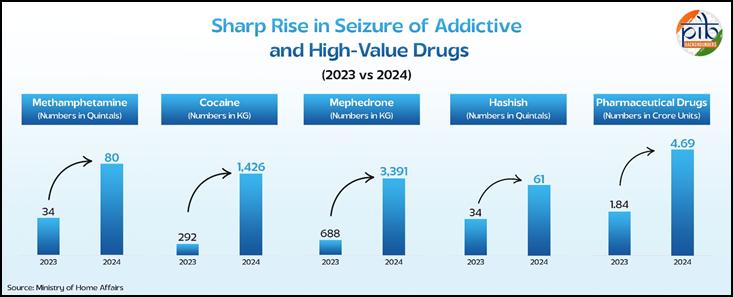
NCB’s Decade of Action
[2]Narcotics Control Bureau (NCB), over the years, has been working tirelessly to break the network of drug trafficking and abuse through a coordinated national strategy. The past decade has seen a sharp increase in cases registered, arrests made, and the quantity and value of drugs seized.
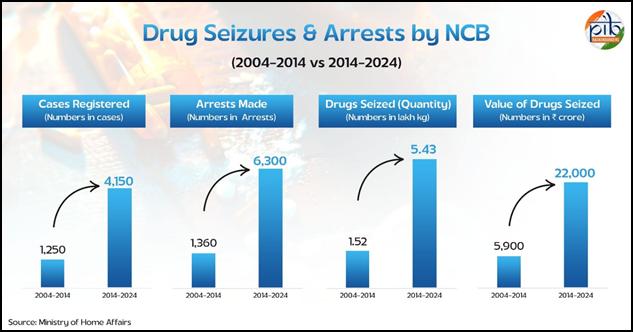
The Narcotics Control Bureau (NCB) was established on 17th March 1986 by the Government of India to lead the national effort against drug trafficking and abuse. Operating under the supervision of the Central Government, NCB coordinates enforcement actions across states and various agencies under the NDPS Act and related laws. It also ensures India’s compliance with international conventions, supports global cooperation to combat drug trafficking, and works with other ministries to address issues related to drug abuse.
To boost nationwide drug enforcement, the Narcotics Control Bureau has been significantly strengthened through major structural expansion.
NCB-specific Expansion
- Regional Offices: Increased from 3 to 7 (e.g., Amritsar, Guwahati, Chennai, Ahmedabad)
- Zonal Offices: Expanded from 13 to 30, including new ones at Gorakhpur, Siliguri, Agartala, Itanagar, and Raipur.
- Staff Strength: Added 536 posts raising sanctioned strength to 1,496.
- Narco-Canine Pool: Nar-K9 units deployed in 10 zonal offices for enhanced detection.
Breaking the Narco-Terror Nexus
In a major step towards eliminating the drug menace, agencies in 2024 achieved the country’s biggest offshore drug seizure. Under the leadership of the Ministry of Home Affairs, a whole-of-the-government approach is being adopted to dismantle drug networks and bring perpetrators to justice.
- In a joint operation carried out by the NCB, the Navy and the Gujarat Police, a gigantic consignment of 3132 kg of drugs was seized.
- Security agencies busted an international drug trafficking cartel and seized over 700 kg of contraband methamphetamine in Gujarat.
- NCB confiscated 82.53 kg of high-grade cocaine in New Delhi.
- The massive drug consignment worth approximately Rs 900 crore was tracked down by a bottom-to-top approach after a quantity of drugs were seized in a courier center in Delhi.
- The agencies also seized narcotics totaling 4,134 kg in the year 2024 from the deep seas.
- In the year 2024, the agencies under MHA destroyed 1,17,284 kg of narcotics.
Measures to Curb Drug Trafficking
The Union government has tried to fight this battle in the last 5 years based on the ‘whole of government approach’ and on the three pillars of structural, institutional and informational reforms.
- 4‑Tier NCORD (Narco-Coordination Centre) Mechanism: Coordination from Apex to District level across all stakeholders via a unified portal.
- Anti-Narcotics Task Force (ANTF): Dedicated teams led by senior police officers in each State/UT to implement NCORD decisions.
- Joint Coordination Committee (JCC): Chaired by the NCB DG to monitor major drug seizures and investigations.
- Empowered Border & Railway Forces: BSF (Border Security Force), Assam Rifles, SSB (Sashastra Seema Bal), Indian Coast Guard and RPF (Railway Protection Force) are authorized under the NDPS Act to carry out search, seizure and arrests in cases related to drug trafficking.
The NDPS Act (1985) is India’s main law to prevent and control drug abuse and illegal drug trafficking. It bans the production, sale, and use of narcotic drugs and psychotropic substances unless allowed for medical or scientific purposes. It provides strict punishments for violations and supports treatment for drug dependents.
- Inter-Agency Joint Operations: NCB coordinates with Navy, Coast Guard, BSF, State ANTF and others for nationwide operations.
- Capacity Building & Training: Ongoing professional training provided to all drug enforcement agencies.
- Darknet & Crypto Task Force: MAC‑level unit focused on cyber drugs trafficking trends, monitoring, and legal updates.
MAC stands for Multi-Agency Centre. At the MAC level, different intelligence and enforcement agencies in India come together to share information, coordinate actions and monitor threats, including those related to drug trafficking, terrorism and organized crime.
- National Helpline (MANAS 1933): 24×7 toll-free platform for drug-related queries and reporting.
- Forensic Lab Support: Central assistance for upgrading State forensic facilities.
- Maritime Security Group – NSCS (National Security Council Secretariat): Established in November 2022 to analyze and address sea-route drug trafficking.
- International Cooperation: DG-level bilateral dialogues with neighbours (Myanmar, Iran, Bangladesh, etc.) focused on maritime and land drug routes.
Fighting Drug Abuse
To address the growing challenge of substance use, the Ministry of Social Justice & Empowerment developed and implemented targeted programmes focused on prevention, treatment and rehabilitation across the country.
Nasha Mukt Bharat Abhiyaan (NMBA)
Launched on 15 August 2020 by the Ministry of Social Justice and Empowerment, Nasha Mukt Bharat Abhiyaan (NMBA) is a nationwide campaign addressing substance abuse through prevention, treatment and rehabilitation.
- NMBA Website: Offers comprehensive resources, real-time dashboards, e-pledge options, and expert-led discussion forums
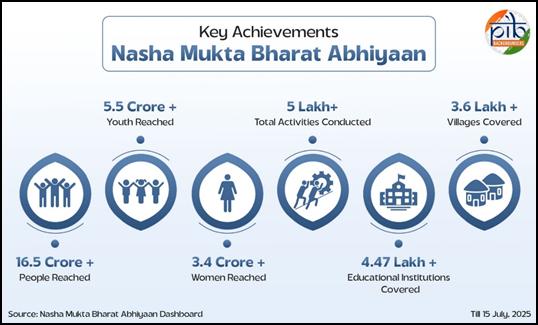
- NMBA Mobile App: Collects and monitors ground-level data, with wide usage by Master Volunteers.
- National Toll-free Helpline (14446): Provides primary counselling and immediate referral services.
Under the Nasha Mukt Bharat Abhiyan, over 16.5 crore+ people have been sensitised about the ill effects of substance abuse. More than 27.76 lakh individuals have received treatment and rehabilitation support. The Government is running over 730 free rehabilitation centres across the country. To strengthen efforts at the community level, more than 10,000 Master Volunteers have been trained to support outreach and awareness activities.
National Action Plan for Drug Demand Reduction (NAPDDR)
The National Action Plan for Drug Demand Reduction (NAPDDR), implemented by the Ministry of Social Justice & Empowerment, is a centrally sponsored scheme under which financial assistance is provided to:
- 342 Integrated Rehabilitation Centres for Addicts (IRCAs) that provide in-patient treatment to drug users along with counselling, detoxification/de-addiction, after care and re-integration into the social mainstream.
- 47 Community based Peer led Intervention (CPLI) programmes work with children below 18 to create awareness against drugs and teach life skills.
- 74 Outreach and Drop In Centres (ODICs) which provide safe and secure space with provision of screening, assessment and counselling and thereafter provide referral and linkage to treatment and rehabilitation services.
- 83 Addiction Treatment Facilities (ATFs) in Government hospitals.
- 53 District De-Addiction Centres (DDACs) which provides all three facilities provided by IRCA, ODIC & CPLI under one roof.
Conclusion
The Youth Spiritual Summit in Varanasi marks a significant step towards a united and action-oriented fight against substance abuse. By bringing together key ministries, enforcement agencies, spiritual leaders and youth organisations, it lays the foundation for a people-led movement rooted in awareness, compassion and collective resolve.
This initiative reflects the Hon’ble Prime Minister’s vision of a fit, addiction-free and self-reliant youth forming the backbone of a developed India. It believes in the power of young citizens, full of vitality and leadership, to lead the nation towards a healthier future.
This Youth Spiritual Summit is not merely an event. It is a national call to action, where policy, community and spirituality come together to create a drug-free and empowered generation
References
Ministry of Youth Affairs and Sports
PIB Backgrounders:
United Nations Office on Drugs and Crime:
Ministry of Home Affairs
Ministry of Social Justice and Empowerment
Social Media Links:
Click here to see pdf
*****
SK/ RK
(Backgrounder ID: 154904)
आगंतुक पटल : 4124
Provide suggestions / comments